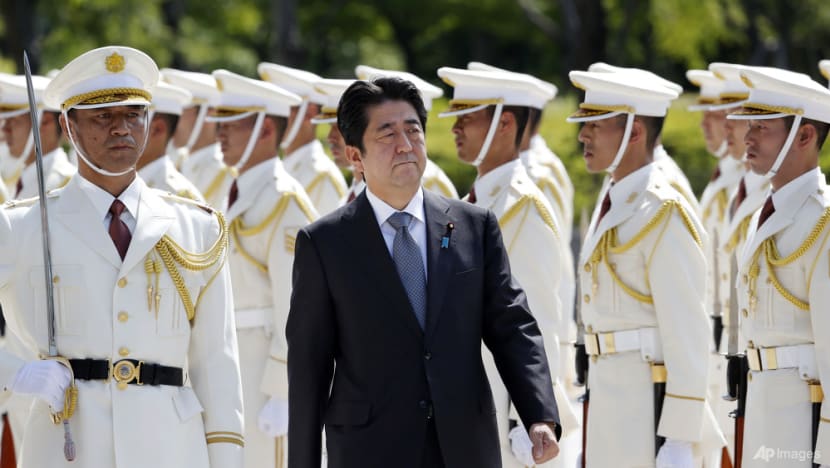Commentary: Shinzo Abe invented the Indo-Pacific
The former Japan prime minister transformed “Indo-Pacific” from a catchphrase into an aspiration, defining a security and economic architecture for the region and beyond, says Bloomberg’s Mihir Sharma.

NEW DELHI: No single term is as ubiquitous in the strategy documents of the free world today as “Indo-Pacific”. And yet the phrase never appeared in defence white papers or summit readouts two decades ago. The geopolitical, geo-economic, and military links between these two great oceans, as well as the democracies that depend on them, are so widely understood today thanks to one man: Shinzo Abe.
Abe, modern Japan’s longest-serving prime minister, tragically assassinated on Friday (Jun 8) while taking part in a campaign rally, invented the Indo-Pacific.
In a landmark speech to India’s parliament during his first term in office, he urged the two nations to create a “broader Asia” at the “confluence of the two seas” — an Asia that would necessarily include other maritime democracies such as Australia, Indonesia and the United States.
The Indo-Pacific is more than a catchphrase. It has become an aspiration. Abe’s words and policies defined a security and economic architecture that now has a chance of preserving free thought and free trade in Asia, the Pacific and beyond.
For that alone, Abe arguably deserves to be remembered as the most consequential democratic leader of the 21st century thus far.
Related:
RELENTLESS PUSH FOR INDIAN AND PACIFIC OCEANS ALLIANCES
India, for one, has long oriented its security around the Eurasian continent. That it has now begun to think of itself as a maritime nation is partly thanks to Abe and his relentless, if polite, pushing of sea-based alliances.
If countries dependent on the Indian and Pacific Oceans are not to be condemned to living in a unipolar world, with China as that single pole, then Abe’s innovations - including the Quad grouping bringing together the US, Japan, India and Australia - are their best hope.
Even so, Abe leaves a reputation in Asia marked by two almost irreconcilable facets. In many countries where Japanese occupation and wartime atrocities are an open wound — kept open, in most cases, by domestic populists — Abe’s quest to remilitarise Japan was not precisely welcome.
I write this column in Berlin, a capital that is also re-arming for the first time since the war, but where few of its neighbors can accuse the political leadership of being apologists for pre-war militarism the way that Abe often appeared to be.
DOMESTIC AND INTERNATIONAL VIEWS ON JAPAN’S REMILITARISATION
Domestically, his liberal opponents understandably saw Abe’s quest to move beyond Japan’s postwar identity as dangerous. He sometimes implied that the values including pacifism - in Japan’s constitution had been “imposed” on the country by the victorious Americans; his opponents fundamentally disagreed.

Yet, in other parts of Asia, Abe was seen as a democrat first: someone who grounded his activist foreign policy in the quest for an essential common purpose for the world’s democracies.
When he wrote the need for a “free and open Indo-Pacific” into multiple joint statements and shared strategies, he may have meant it as a statement about protecting free trade in the world’s most crowded and contested shipping lanes. But he also wanted it read as a defence of basic, universal rights in an age of rising authoritarianism, and that is also how most of his partners saw it.
Certainly, those writing the position papers and policies about new alliances and partnerships in the Indo-Pacific - including here in Germany - want a Japan that looks outward, one that takes on more security responsibilities.
That’s the Japan that Shinzo Abe promised all of us.
HOW SHINZO ABE WILL BE SEEN
How to embrace a remilitarising Japan without defending its past militarism is an open question and one that Abe himself — descended, after all, from the country’s wartime elite — was poorly placed to answer.
An Abe-ism after Abe might find it easier to thread that needle. To me, at least, the populist tide that has overrun democracies the world over since Abe’s first term makes his own nationalism look somewhat less dangerous.
Indeed, it’s now easier for me to remember him instead, in David Frum’s words, as “one of the great internationalists of his era, the leading architect of collective security in the Indo-Pacific region.” In India, certainly, there is no doubt as to whether Abe was a friend: Prime Minister Narendra Modi announced that the country would observe a day of official mourning for him, an honour very few foreign leaders receive.
Nationalist or internationalist? Militarist or democrat? In the end, how Abe will be seen will depend on the actions, over the next decades, of the Japan that he shaped.
In an op-ed written on the very day that he took office for the second time, in 2012, Abe said his top priority was to “expand Japan’s strategic horizons.” He did.
But he also insisted that “Japan’s diplomacy must always be rooted in democracy, the rule of law and respect for human rights.”
A Japan that serves proudly as a keystone for a democratic, open and inclusive economic and political architecture in the Indo-Pacific will leave the world in no doubt about which of Abe’s two faces should ultimately be remembered.














